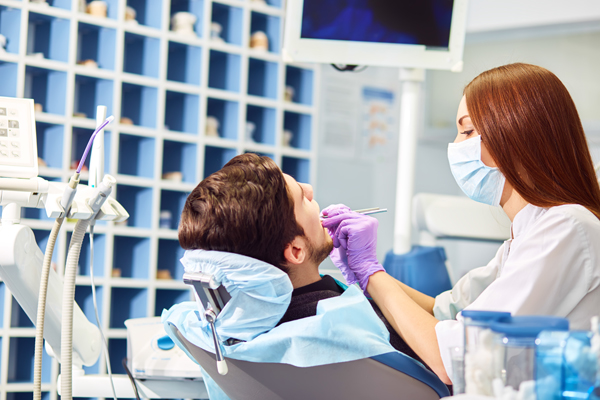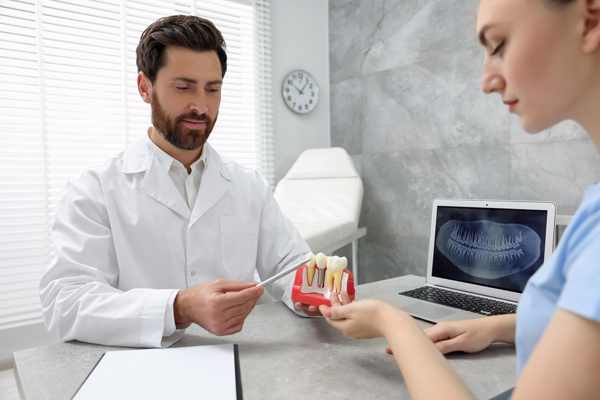How Lasers Help Treat Gum Disease

You may have recently had a dental checkup and been told that you have gum disease. While no one likes to find out they have a gum infection, there are various treatment options available, depending on the severity of your condition. Laser periodontal treatment, for example, is a minimally invasive alternative to conventional treatments.
Periodontal disease: an overview
Periodontal disease, often known as gum disease, is an inflammation of the tissues and bones that support the teeth. Periodontitis is the more advanced stage of gum disease. If identified in the gingivitis stage, gum disease may be reversed with a strict oral hygiene program. On the other hand, advanced periodontal disease requires the intervention of a dental professional. Periodontal disease has a number of risk factors, including smoking, poor oral hygiene, diabetes, some medications, and genetics.
Periodontal disease is usually treated with scaling and root planing. Tartar, plaque (biofilm), and bacteria are removed from the tooth at and below the gum line and the roots, using this non-surgical thorough cleaning. It also encourages the regeneration of the gum tissue, allowing it to fit tightly around the tooth.
The process of laser therapy
Laser therapy is often used in combination with other conventional treatments. The dentist will use a laser to reach and remove inflammatory gum tissue from around the tooth's root with gum laser treatment. The tartar and plaque accumulated under and around the gum line are removed. Afterward, the dentist will smoothen any rough area on the teeth using a specialized tool. Eliminating these rough patches makes it harder for the teeth and gums to collect bacteria and suffer infection again.
The oral cavity will require time to recover and renew after laser treatment. The gums should be free of infection and attach to the teeth again. It is worth noting that not all dentists employ laser treatment. Those who choose to use this treatment to treat patients get laser training. This guarantees that they are using the right technique and understand how to employ various wavelengths effectively.
The benefits
Lasers have many advantages when it comes to removing unhealthy gum tissue. The following are the four primary benefits of employing laser treatment to treat gum disease:
- Faster healing and recovery
- No general anesthesia is required
- Lasers can carefully and precisely target infected tissues
- Periodontal laser treatment is less intrusive than traditional surgery, so there is less bleeding, discomfort, and edema
Laser periodontal therapy's effects are currently being researched. According to the American Academy of Periodontology, there is presently insufficient data to show that this treatment strategy is superior to standard periodontal therapy. However, it has demonstrated encouraging benefits for those who are eligible.
In conclusion
You may think that laser gum treatment is the best solution for you. It is amazing how far dental procedures have progressed, and having a less unpleasant and intrusive alternative for treating gum disease is generally preferable. The best course of action is to get advice from a qualified dental professional when making this choice. You should feel free to inquire about laser treatment, but keep in mind that many choices have been proven to be safe and successful.
Request an appointment here: https://www.agawamdentalarts.com or call Agawam Dental Arts at (413) 362-7815 for an appointment in our Feeding Hills office.
Check out what others are saying about our dental services on Yelp: Gum Disease in Feeding Hills, MA.
Recent Posts
Gum disease treatment addresses the root source of the disease and halts the ramifications. Gum disease, or periodontal disease, is a common condition that damages the gums and the structures that support the teeth. If left untreated, it can cause serious problems, including tooth loss. The good news is that if caught early, these treatments…
According to the Centers for Disease Control and Prevention, almost half of the United States population has some form of gum disease by the time they reach the age of 30. The risk increases by age 65, with over 70% of Americans experiencing this issue later in life. While gum disease is very treatable, it…
Avoiding gum disease at all costs is essential, as once someone is diagnosed with this dental-related disease, it means that they are in need of additional dental treatment to restore their good oral health. Even though gingivitis is the mildest form of gum disease, it can still cause harm to one’s overall good oral health.Thinking…
Gum disease is a progressive condition that is caused by bacteria in the mouth getting into gum tissues. Your immune system responds to this invasion by sending off antibodies to fight off the invaders. The ensuing battle leads to inflammation and damage to the structures that support teeth.The first stage of gum disease is called…


